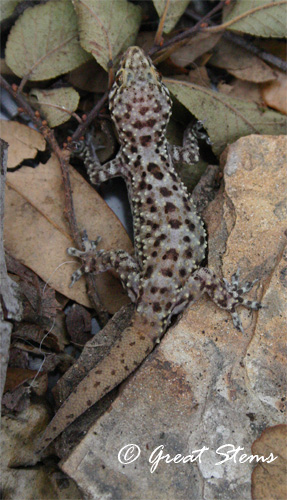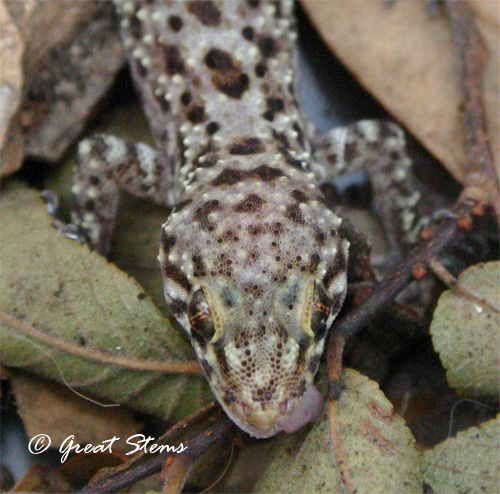In moving dirt and leaves around the garden, we periodically discover a hiding animal. This little creature is a Mediterranean Gecko (Hemidactylus turcicus).
 By the name, I am sure you can tell that it’s not native to Texas, nor to anywhere else in the United States. Its ancestors most likely came from Southern Europe, or perhaps Northern Africa or Southwest Asia. But this gecko’s cousins and siblings have become a common sight in the urban environment in other regions these days, particularly in the southern states and other tropical-subtropical areas. Lots of southern gardeners, so used to seeing Mediterranean Geckos around or even in their house, probably don’t even realize that these wall-climbing lizards with their cute toe pads haven’t always been here. In fact, the first published report of these geckos in Texas was made in 1955.
By the name, I am sure you can tell that it’s not native to Texas, nor to anywhere else in the United States. Its ancestors most likely came from Southern Europe, or perhaps Northern Africa or Southwest Asia. But this gecko’s cousins and siblings have become a common sight in the urban environment in other regions these days, particularly in the southern states and other tropical-subtropical areas. Lots of southern gardeners, so used to seeing Mediterranean Geckos around or even in their house, probably don’t even realize that these wall-climbing lizards with their cute toe pads haven’t always been here. In fact, the first published report of these geckos in Texas was made in 1955.
 As far as invasive animal species go, this one is currently listed as having “minimal impact” on the native wildlife populations. But there are plenty of invasive species muy malos out there — European Starlings, Zebra Mussels, Japanese Beetles, Wild Boars (a.k.a. feral hogs), and a long list of other insect, aquatic, and vertebrate species. Starlings and English House Sparrows, for example, kill or push out Purple Martins and take over their nesting cavities. Feral hogs spread destruction and disease across the countryside and in many urban areas. Introduced earthworms are affecting northern forest ranges. Red-Eared Sliders, turtles native to Texas and considered friendly sights here, are problems in many other states and countries because they adapt easily to the local environmental conditions and affect native turtle populations. I’m not even listing some of the worst offenders.
As far as invasive animal species go, this one is currently listed as having “minimal impact” on the native wildlife populations. But there are plenty of invasive species muy malos out there — European Starlings, Zebra Mussels, Japanese Beetles, Wild Boars (a.k.a. feral hogs), and a long list of other insect, aquatic, and vertebrate species. Starlings and English House Sparrows, for example, kill or push out Purple Martins and take over their nesting cavities. Feral hogs spread destruction and disease across the countryside and in many urban areas. Introduced earthworms are affecting northern forest ranges. Red-Eared Sliders, turtles native to Texas and considered friendly sights here, are problems in many other states and countries because they adapt easily to the local environmental conditions and affect native turtle populations. I’m not even listing some of the worst offenders.
Does the Mediterranean Gecko displace native lizards? It certainly has a tendency to be territorial, so there probably is a little of that going on. But considering that it likes to co-exist with humans, often hanging around exterior lighting on houses and other buildings — it’s possible that there is minimal overlap between it and other species, but I’m no expert. If it has found its own niche in the habitat, then it seems reasonable that the native lizards won’t be threatened, though studies are certainly incomplete. Far more dangerous to native wildlife, in my opinion, is the use of pesticides to kill off insects, which are food sources to countless animal species.

Mediterranean Geckos (actually one of four introduced gecko species in Texas) are easily distinguished from our native Texas geckos, the Texas Banded Gecko and the Reticulated Banded Gecko (both are found in the Big Bend area). The Mediterranean Gecko has bumpy, spotted skin, sticky toe pads, and tiny claws. Its eyes have vertical pupils but no eyelids — please skip the staring contest with this one. You’ll lose.
 One of its more fascinating aspects is that it can lose its tail to escape a predator and then regenerate it– such regeneration takes about three weeks. I wonder whether this gecko went through that process — its tail looks distinctly different from the rest of it.
One of its more fascinating aspects is that it can lose its tail to escape a predator and then regenerate it– such regeneration takes about three weeks. I wonder whether this gecko went through that process — its tail looks distinctly different from the rest of it.
The dark spots help the gecko hide in the leaves, but the gecko can lighten its coloration as necessary to blend into other areas. At night it can be quite pale.
 I will say this about Mediterranean Geckos — they love to eat cockroaches, of which the South surely has more than enough to go around. The geckos love moths, too — you can see why hanging around a house at night is a pretty great place for a gecko to be. Just stay away from my native lizards, gecko, and we’ll get along fine.
I will say this about Mediterranean Geckos — they love to eat cockroaches, of which the South surely has more than enough to go around. The geckos love moths, too — you can see why hanging around a house at night is a pretty great place for a gecko to be. Just stay away from my native lizards, gecko, and we’ll get along fine.
Incredible shots. I was leaving a comment on your other post and my internet went out in the middle so I don’t think it went through- was commenting on your incredible shots of the wildlife. This is my first day visiting your blog and I love it. Great captures. Love the owl photo as well- it is as if they are looking directly at you and posing.
Enjoyed my visits! Thanks!
Love those little guys! We don’t have them around here, so it’s always fun to see them scurrying about when we vacation in the South!
That is one beautiful reptile, native or not! I have *got* to attract something reptilian to my yard.
(I’d love for you to do a post of your best/favorite lizard photos collected from previous posts.)
Alan, you really do like lizards, don’t you? Next good lizard photo, I’ll see what I can do. You’re going to have me out hunting lizards! 🙂
Katherine, glad to have you stop by! You are welcome anytime. I’m going to get to your nursery as soon as I can!
I imagine the geckos just can’t handle the cold up there — I think they like it 65 degrees F or more as much as possible. But at least you can visit!
There have been so many lizards in the yard lately! I’m loving it…they were MIA a bit earlier in the season and I was worried something got to them but it’s all good. Great shots of this little guy.
Meredith, I suppose it’s because I don’t have them in my garden (yet). Years ago I read a comment about somebody who moved to the St. Louis area from Australia and said that one of their favorite things about the area were the squirrels. (No squirrels in Australia.)
We humans are never satisfied with what we have, but gardeners even less than usual I think. 🙂
I understand, Alan — I wish I could attract everything to my yard. Maybe someday, hehe!
I’m so glad you are seeing your lizards again, Cat! They are such a pleasure to have around.
I hardly ever see the geckos outside of the house, and once they’re inside they eat the stray roaches (so I love them). Unfortunately, my cat also loves them. sigh.
OH! I also planted the guara seed I got from you (1 plant made it), and the beautyberry (with one plant as of right now).
Katina, I’m glad to hear you’ve got some plants growing from seed. I’m going to try some seeds a little later this summer and see if I can get them ready for fall. It will be tough going if we have 100+ weather all summer, though. 🙁